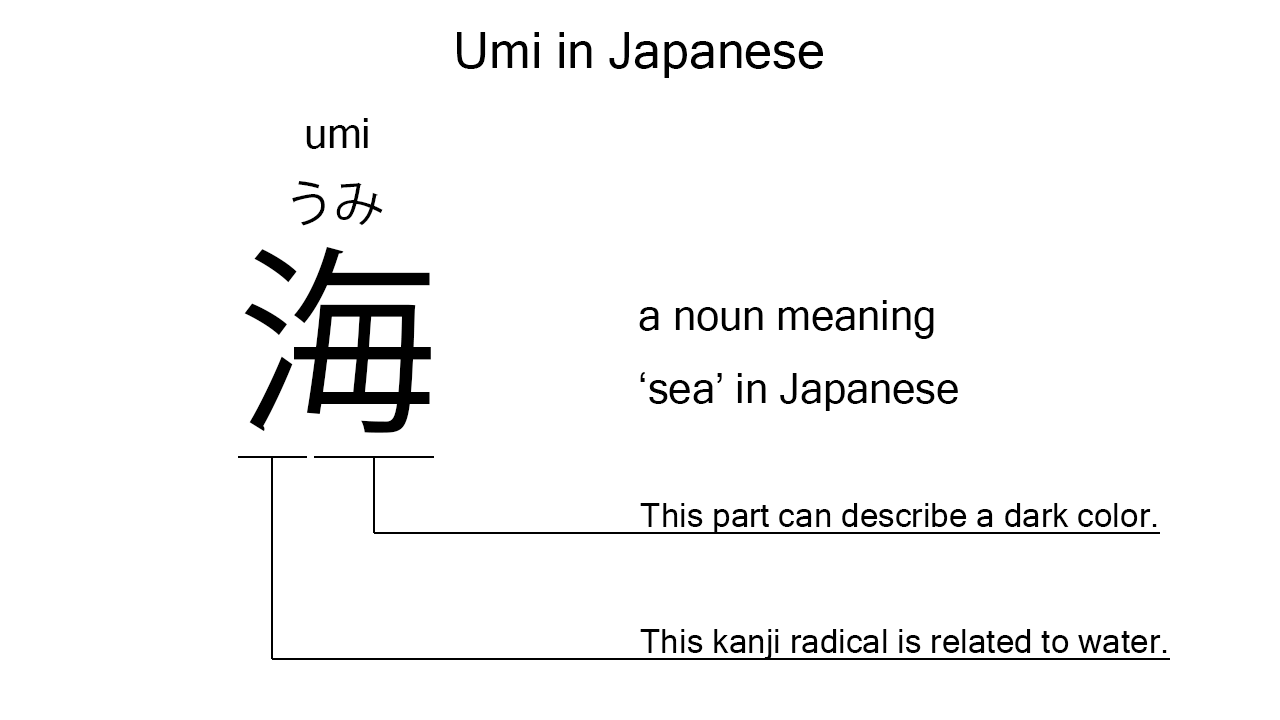What does “umi” mean in Japanese?
Native speakers say “umi” to mean ‘sea’ or ‘ocean’ in Japanese. Perhaps, some Japanese learners know this word as it is sometimes used in Japanese movies, songs, novels, manga, anime, and the like. In this blog post, however, I will explain this word in detail together with its kanji character. And also, I will explain how to use it through example sentences. My explanations would help Japanese learners understand “umi” more clearly. Then, let’s get started!
Contents
Definition and meanings of “umi”
Let me start with the definition and meanings of “umi”.
- umi – 海 (うみ) : a noun meaning ‘sea’ or ‘ocean’ in Japanese.
This kanji character consists of two different parts. The left part is a kanji radical related to water; the right one is used to describe a dark color. So, this kanji character literally expresses dark colored water. This concept is not completely in line with the actual meanings, but still suitable for the deep area of the sea, I think.

The definition and meanings of “umi” are simple and clear, I think. Then, let me explain how to use it through the example sentences below.
Example #1: how to say “the sea” in Japanese
watashi tachi wa kinou umi ni it ta – 私達は昨日海に行った (わたしたちはきのううみにいった)
We went to the sea yesterday.
Below are the new words used in the example sentence.
- watashi – 私 (わたし) : a pronoun meaning ‘I’ in Japanese.
- tachi – 達 (たち) : a suffix used after a noun or pronoun to make its plural form. In the example, this is used after “watashi” to make its plural form, “watashi tachi”, which means ‘we’ in Japanese. Learn more about Japanese plural.
- wa – は : a binding particle working as a case marker or topic marker. In the example, this works after “watashi tachi” to make the subject in the sentence.
- kinou – 昨日 (きのう) : a noun meaning ‘yesterday’ in Japanese. This can also work as an adverb. In the example, this works as an adverb in the middle of the sentence to say “yesterday” in Japanese.
- ni – に : a case particle used to say where someone or something goes. In the example, this is used after “umi” to say where the speakers went yesterday.
- it – 行っ (いっ) : one conjugation of the verb, “iku“, which means ‘to go’ in Japanese. In the example, it has been conjugated for the better connection with its following word.
- ta – た : an auxiliary verb used after a verb, adjective, or auxiliary verb to make its past tense form. In the example, this is used after the conjugated verb, “it”, to make its past tense form, “it ta”.
This is a typical usage of “umi”. In this example, it works together with “ni” to say “to the sea” in Japanese. Word orders in Japanese and English are different, but the role of “ni” is very similar to that of the English preposition, “to”. When we want to mean ‘the sea’ in Japanese, anyway, “umi” is a very good option.
Example #2: another usage of “umi”
yoru no umi wa kirei desu ne – 夜の海は綺麗ですね (よるのうみはきれいですね)
The sea is beautiful at night, isn’t it?
Below are the new words used in the example sentence.
- yoru – 夜 (よる) : a noun meaning ‘night’ in Japanese.
- no – の : a case particle joining two nouns. Normally, the first one can work as a modifier to describe the second. In the example, this works to join “yoru” and “umi”. The formed phrase literally means ‘the night sea’ in Japanese. It has been translated as ‘the sea at night’ in this example, though.
- kirei – 綺麗 (きれい) : the stem part of the na-adjective, “kireina“, which means ‘beautiful’ in Japanese.
- desu – です : an auxiliary verb used after a noun or adjective to make it polite. Probably, this is well known as a part of Japanese desu form. In the example, this is used after “kirei” to make it sound polite.
- ne – ね : a sentence-ending particle often used to ask for agreement softly. The role of this particle is similar to those of English tag questions. In this example, this has been translated into English as “isn’t it?”
This is another typical usage of “umi”. In this example, it works as a part of the noun phrase, “yoru no umi”, which means ‘the sea at night’ in Japanese.
Summary
In this blog post, I’ve explained the definition and meanings of “umi” in detail together with its kanji character. And also, I’ve explained how to use it through the example sentences. Let me summarize them as follows.
- umi – 海 (うみ) : a noun meaning ‘sea’ or ‘ocean’ in Japanese. This kanji character consists of two different parts. The left part is a kanji radical related to water; the right one is used to describe a dark color. So, this kanji character literally expresses dark colored water. This concept is not completely in line with the actual meanings, but still suitable for the deep area of the sea, I think. When we want to say “sea” or “ocean” in Japanese, this noun is a very good option.
Hope my explanations are understandable and helpful for Japanese learners.